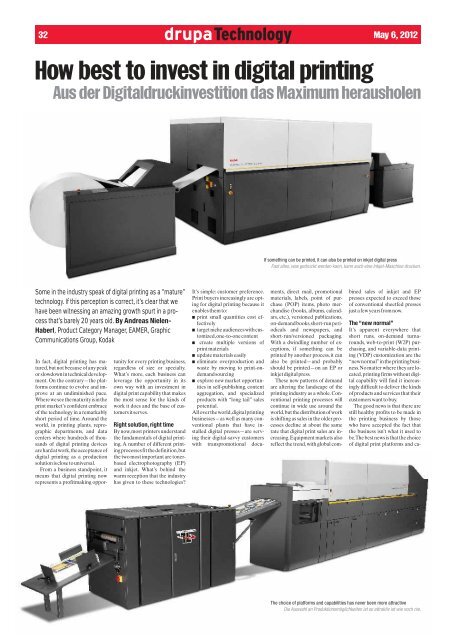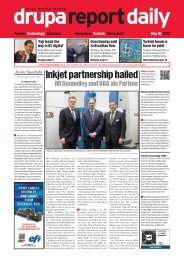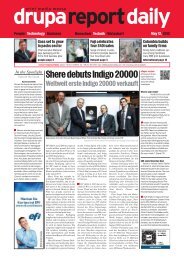drd 2012-05-06 - Drupa Report Daily
drd 2012-05-06 - Drupa Report Daily
drd 2012-05-06 - Drupa Report Daily
Erfolgreiche ePaper selbst erstellen
Machen Sie aus Ihren PDF Publikationen ein blätterbares Flipbook mit unserer einzigartigen Google optimierten e-Paper Software.
32 drupa Technology<br />
May 6, <strong>2012</strong><br />
How best to invest in digital printing<br />
Aus der Digitaldruckinvestition das Maximum herausholen<br />
If something can be printed, it can also be printed on inkjet digital press<br />
Fast alles, was gedruckt werden kann, kann auch eine Inkjet-Maschine drucken.<br />
Some in the industry speak of digital printing as a “mature”<br />
technology. If this perception is correct, it’s clear that we<br />
have been witnessing an amazing growth spurt in a process<br />
that’s barely 20 years old. By Andreas Nielen-<br />
Haberl, Product Category Manager, EAMER, Graphic<br />
Communications Group, Kodak<br />
In fact, digital printing has matured,<br />
but not because of any peak<br />
or slowdown in technical development.<br />
On the contrary—the platforms<br />
continue to evolve and improve<br />
at an undiminished pace.<br />
Where we see the maturity is in the<br />
print market’s confident embrace<br />
of the technology in a remarkably<br />
short period of time. Around the<br />
world, in printing plants, reprographic<br />
departments, and data<br />
centers where hundreds of thousands<br />
of digital printing devices<br />
are hard at work, the acceptance of<br />
digital printing as a production<br />
solution is close to universal.<br />
From a business standpoint, it<br />
means that digital printing now<br />
represents a profitmaking oppor-<br />
tunity for every printing business,<br />
regardless of size or specialty.<br />
What’s more, each business can<br />
leverage the opportunity in its<br />
own way with an investment in<br />
digital print capability that makes<br />
the most sense for the kinds of<br />
work it does and the base of customers<br />
it serves.<br />
Right solution, right time<br />
By now, most printers understand<br />
the fundamentals of digital printing.<br />
A number of different printing<br />
processes fit the definition, but<br />
the two most important are tonerbased<br />
electrophotography (EP)<br />
and inkjet. What’s behind the<br />
warm reception that the industry<br />
has given to these technologies?<br />
It’s simple: customer preference.<br />
Print buyers increasingly are opting<br />
for digital printing because it<br />
enables them to:<br />
■ print small quantities cost effectively<br />
■ target niche audiences with customized,<br />
one-to-one content<br />
■ create multiple versions of<br />
print materials<br />
■ update materials easily<br />
■ eliminate overproduction and<br />
waste by moving to print-ondemand<br />
sourcing<br />
■ explore new market opportunities<br />
in self-publishing, content<br />
aggregation, and specialized<br />
products with “long tail” sales<br />
potential.<br />
All over the world, digital printing<br />
businesses—as well as many conventional<br />
plants that have installed<br />
digital presses—are serving<br />
their digital-savvy customers<br />
with transpromotional documents,<br />
direct mail, promotional<br />
materials, labels, point of purchase<br />
(POP) items, photo merchandise<br />
(books, albums, calendars,<br />
etc.), versioned publications,<br />
on-demand books, short-run periodicals<br />
and newspapers, and<br />
short-run/versioned packaging.<br />
With a dwindling number of exceptions,<br />
if something can be<br />
printed by another process, it can<br />
also be printed—and probably<br />
should be printed—on an EP or<br />
inkjet digital press.<br />
These new patterns of demand<br />
are altering the landscape of the<br />
printing industry as a whole. Conventional<br />
printing processes will<br />
continue in wide use around the<br />
world, but the distribution of work<br />
is shifting as sales in the older processes<br />
decline at about the same<br />
rate that digital print sales are increasing.<br />
Equipment markets also<br />
reflect the trend, with global combined<br />
sales of inkjet and EP<br />
presses expected to exceed those<br />
of conventional sheetfed presses<br />
just a few years from now.<br />
The “new normal”<br />
It’s apparent everywhere that<br />
short runs, on-demand turnarounds,<br />
web-to-print (W2P) purchasing,<br />
and variable-data printing<br />
(VDP) customization are the<br />
“new normal” in the printing business.<br />
No matter where they are located,<br />
printing firms without digital<br />
capability will find it increasingly<br />
difficult to deliver the kinds<br />
of products and services that their<br />
customers want to buy.<br />
The good news is that there are<br />
still healthy profits to be made in<br />
the printing business by those<br />
who have accepted the fact that<br />
the business isn’t what it used to<br />
be. The best news is that the choice<br />
of digital print platforms and ca-<br />
The choice of platforms and capabilities has never been more attractive<br />
Die Auswahl an Produktionsmöglichkeiten ist so attraktiv ist wie noch nie.






